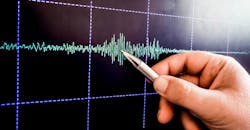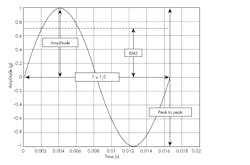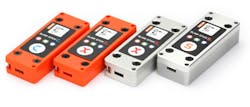8 Environmental Factors affecting Vibration Measurement Accuracy
Part 1 of this series addressed the advantages and disadvantages of various vibration sensors; Part 2 examined signal conditioning and system hardware selection and configuration. I’ll wrap up by discussing the potential impact of various environmental factors on vibration measurement accuracy, as well as provide a short overview on vibration analysis.
Environmental Factors
The environment in which vibration measurements are performed can have a significant impact on their accuracy:
Temperature. Temperature is the most significant environmental concern. All sensors will have some temperature dependence, especially piezoelectric accelerometers, so temperature compensation will be needed to offset these effects. Although some sensors have the necessary compensation hardware integrated into the sensor package, in others, it may be necessary to add a temperature sensor and perform compensation.
Base strains. Many piezoelectric accelerometers use a piezoelectric element with a tip mass mounted to the base and measuring shear. When the surface the accelerometer is mounted to experiences strain, this can often appear as “acceleration” in the data. Although accelerometer manufacturers design their sensors to minimize the effect, base strains can still result in erroneous data.
Acoustic noise. Noise is simply pressure waves that can excite the accelerometer and the structure under test. Although these induced vibrations are normally much less than the actual inherent structural vibrations, they remain something to consider.
Transverse vibrations. Accelerometers are sensitive to vibrations acting in directions perpendicular or orthogonal to the main axis of interest. This transverse sensitivity is typically less than 5% for single-axis accelerometers; triaxial accelerometers typically have a little higher transverse sensitivity.
Magnetic fields. The magnetic sensitivity of accelerometers is very low, but this effect should be considered, especially in extreme environments like naval vessels.
Humidity. Although most accelerometers are sealed to ensure reliable operation in humid environments, humidity can cause issues at cable connections. Particularly humid environments may require pre-wired special accelerometers to ensure accurate data. Data loggers and vibration meters may also need special housings or accessories for humid environments.
Corrosive substances. Accelerometers or data loggers with plastic housings may be susceptible to corrosive agents, so prevent these substances from coming into contact with data acquisition equipment.
Shock and vibration. Consider what the data acquisition electronics will be required to withstand during use. Electronics that are well-suited to use in a lab might not be able to survive use in the field. Field applications might require robust electronics and/or special accessories and cases to dampen shock and vibration levels to which the electronics will be exposed.
Vibration Analysis Basics
Acquiring the vibration data is only part of the challenge of vibration measurement; the other part is the analysis of the data acquired. It’s important to understand the types of waveforms associated with vibration analysis, the important differences between them, and when it is appropriate to use each type of vibration analysis tool. However, in an article of this length, it’s unrealistic to attempt an in-depth exploration of this topic. To gain a better understanding of how and when to use various forms of vibration analysis, check out the resources listed at the end of the article.
Time domain vibration analysis starts with a time-varying, real-world signal from a transducer or sensor. Analyzing vibration data in the time domain (amplitude plotted against time) is limited to a few parameters in quantifying the strength of a vibration profile: amplitude, peak-to-peak value, and RMS. Figure 1 is a simple sine wave with these parameters identified.
1. A simple 60-Hz sine wave with the amplitude, peak-to-peak, RMS, frequency, and period identified.
- The peak or amplitude is valuable for shock events, but it doesn’t take into account the time duration and thus the energy in the event.
- The same is true for peak-to-peak value with the added benefit of providing the maximum excursion of the wave, which is useful when looking at displacement information—specifically clearances.
- The RMS (root mean square) value is generally the most useful because it is directly related to the energy content of the vibration profile, and thus the destructive capability of the vibration. RMS also takes into account the time history of the wave form.
Vibration is an oscillating motion about equilibrium, so most vibration analysis looks to determine the rate of that oscillation or the frequency, which is proportional to the system’s stiffness. The number of times a complete motion cycle occurs during a period of one second is the vibration’s frequency and is measured in hertz (Hz). For simple sine waves, the vibration frequency could be determined from looking at the waveform in the time domain; however, as different frequency components and noise are added, spectrum analysis is necessary to obtain a clearer picture of the vibration frequency.
Frequency Domain Vibration Analysis
The fast Fourier transform (FFT) is an efficient algorithm used to compute a discrete Fourier transform (DFT). This Fourier transform outputs vibration amplitude as a function of frequency so that the analyzer can understand what is causing the vibration. The frequency resolution in an FFT is directly proportional to the signal length and sample rate. To improve the resolution, the time of the recording must be extended, but be careful of a changing vibration environment.
A spectrogram takes a series of FFTs and overlaps them to illustrate how the spectrum (frequency domain) changes with time. If vibration analysis is being done on a changing environment, a spectrogram can be a powerful tool to illustrate exactly how that spectrum of the vibration changes.
A power spectral density (PSD) takes the amplitude of the FFT, multiplies it by its complex conjugate, and normalizes it to the frequency bin width. This allows for accurate comparison of random vibration signals that have different signal lengths. For this reason, PSDs are typically used to describe random vibration environments like those specified in military and commercial test standards.
Conclusion
Obviously, this series has only touched on some of the high points of vibration measurement. To learn more about tools and techniques for making better vibration measurements, including those optimized for making measurements in the field (Fig. 2), visit the Midé Technology website.
2. Slam Stick data loggers are designed to measure acceleration in all three axes while simultaneously measuring temperature and pressure. Rugged enclosures and a wide temperature operating range allow them to perform in a variety of harsh environments.
Want to Learn More?
The following resources on vibration analysis tools and techniques may be helpful:



